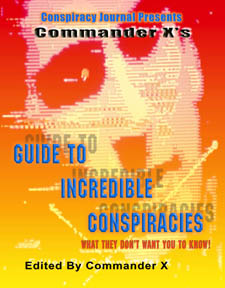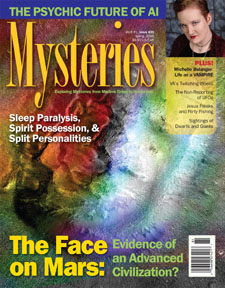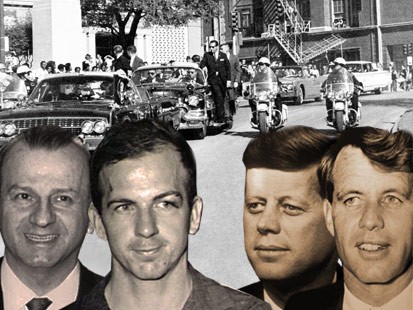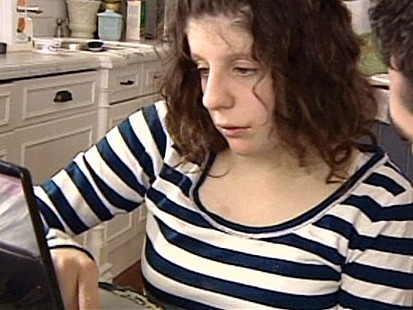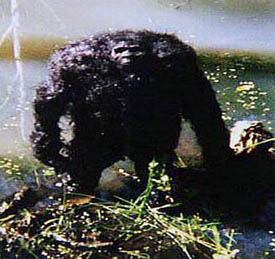-
THINGS THAT GO BUMP IN THE NIGHT DEPARTMENT -
Tales of the Beaman Monster Linger
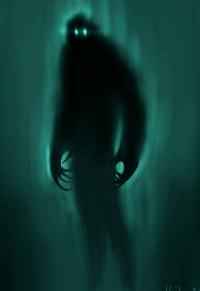

After six years of agonising pain, Ailsa Marsh was stunned to the core when a spiritual healer managed to banish her suffering in an instant.
"It was gone in the blink of an eye," says Ailsa, a 28-year-old complementary medicine student from Newcastle-Upon-Tyne. "It felt as if he had put his hands inside my shoulders and turned off a tap."
"Before the healing I was constantly wracked with tortuous pain. I was bed-ridden with ME and couldn't leave the house. All of my senses became hypersensitive. If somebody spoke to me it felt as if they were shouting. I couldn't bear the light so my parents hung duvets over the windows. Even lying in bed or sitting down was difficult and painful.
"It got to the stage where I just wanted to end my life. The only reason I didn't kill myself was because I couldn't bear the thought of my mother finding my body."
Ailsa's suffering began in 1998 following a bout of glandular fever. At the time she was a bright, gregarious politics and philosophy student at Durham University. But the disease robbed her of drive and energy, eventually forcing her to leave university and return home to her parents. Over the following months she became weaker and weaker and was eventually diagnosed with ME, a disease which leaves the sufferer listless and bed-ridden. It also left Ailsa in intense pain.
Conventional medicine offered no hope. She saw over 20 doctors and was hospitalised countless times. All doctors drew the same conclusions: they could find no cause for the ME and there was no cure.
Then in January 2004, quite by chance, Ailsa read an article about the spiritual healer David Cunningham.
"I'd tried everything else," says Ailsa. "So I thought I might as well try David.
"I went along not knowing what to expect. I thought he might start chanting at me or making weird symbols with his hands. Instead he listened intently to me for about half an hour. He then put on a tape of soothing music and I began to relax.
"David then placed his hands about a centimetre above my shoulders. I felt as if he was putting his hands inside me and untwisting a tap. The pain just vanished. It went in an instant. That day I left David with more energy than I'd had in six years."
Over the following four months, Ailsa returned every week to complete the healing. Within a few months she was able to go shopping and walk from one side of Newcastle to the other.
"After ten months I went on a family holiday," says Ailsa. "There's pictures of me doing handstands in the sea. I'd gone from being in a wheelchair to being able to do all the normal things a woman of my age could do. That's when I knew I was alright. I'd recovered!"
Although Ailsa is utterly convinced that David Cunningham cured her of ME, many others are rightly sceptical. How can a man with no medical training treat a chronic painful disease merely by placing his hands over a patient's body? No drugs were administered and no operations performed. Even the maligned "placebo effect", where a patient ‘tricks' themself into getting better, takes far longer to take effect. Everything we know about conventional medicine screams that spiritual healing is a myth, a delusion and a hoax perpetrated on the feeble minded.
For these reasons and more, cases such as Ailsa's have been dismissed by researchers for decades. But now scientists in the US and UK may have found proof that prayer and spiritual healing might actually work.
Professor Harald Walach, from the University of Northampton, says: "We should take this phenomenon seriously even if we don't understand it. To ignore it would be unscientific.
"Our work shows that there is a strongly significant effect."
The most common form of spiritual healing in Britain remains the humble prayer. When you are really up against the wall, only the most devout of sceptics manages to resist a prayer. And who doesn't pray for a loved one when they are dying?
Despite being the most widely practised alternative remedy, science has only recently begun to investigate whether spiritual healing actually works. Scientists and doctors simply assumed that it didn't because there is no obvious way that it could.
One of the first attempts to investigate healing focused on its flipside - the curse. In the late 1960s, American scientists decided to see whether focusing bitter, vindictive and negative thoughts on a mould - the scientific equivalent of the witch's curse - could inhibit its growth. Out of 194 mould samples ‘cursed', 151 showed retarded growth. And if all that wasn't strange enough, in later experiments some of those attempting to influence the mould were stationed 15 miles away. Other scientists soon found that negative thoughts could also slow the growth of the food poisoning bug E. coli.
With potency like that, it's hardly surprising that the US military started taking an interest. They were not interested in killing mould and bacteria of course, but people. The renowned psychic Uri Geller was even recruited into a secret programme to harness the power of negative thought to kill Uri Andropov, head of the KGB. Uri left when his masters decided to test his powers by asking him to psychically kill a pig by stopping its heart. It clearly hadn't occurred to them that a vegetarian would be extremely reluctant to kill an entirely innocent animal.
At around the same time, civilian scientists began researching whether prayer and spiritual healing could be used to help animals. Experiments quickly revealed that mice awake faster after a general anaesthetic if healing thoughts are sent their way. In other studies, mice recovered faster and more completely from a form of breast cancer if healers "laid on hands" whilst sending them positive thoughts and energy. Positive thoughts were soon shown to help human blood cells resist damage and brain cells to grow faster.
If healing helps ailing lab animals, might it also help the sick to recover faster? Surprising as it seems, there's growing evidence that it just might. According to the cardiologist Dr Randolph Byrd at San Francisco General Hospital, heart patients who are prayed for by Christians need less medicine and suffer fewer complications. In case you were thinking that he is a wacko fringe scientist, its worth noting that his work was published in the prestigious Southern Medical Journal and numerous other scientists have found similarly inexplicable results.
And prayer doesn't just appear to help heart patients. In virtually every area they have looked, scientists have found evidence that praying for the sick helps them recover faster. For example, studies at the California Pacific Medical Center on AIDS patients found that they survive in greater numbers, become sick less often and recover faster than those who are not prayed for.
All these studies beg the question: which form of spiritual healing works the best? Is Reiki better than the traditional, almost biblical, "laying on of hands". Is Buddhist meditation as good as praying to the Christian God? Or does something as simple as relaxing and cultivating a positive mental attitude beat them all into a cocked hat? It's extremely difficult to answer questions like this, but scientists have discovered the tantalising possibility that the kind of prayers taught in Sunday school might be the best of all.
Several years ago spiritual healers from around the world were recruited into a study to answer just this question. Dr Michael Krucoff, a respected cardiologist at Duke University in the US, persuaded people from a range of faiths and beliefs to help him. Jews left prayers at the Western Wall in Jerusalem, Buddhists prayed in monasteries in Nepal and France, Carmelite nuns in Baltimore offered prayers during vespers, and Moravians, Baptists and fundamentalist Christians prayed in church.
It turned out that those who were prayed for in the traditional manner fared the best, followed by those who had been treated by the "laying on of hands" or who had been coached in stress reduction. Those undergoing conventional medical treatments fared least well.
Surely, whilst admittedly fascinating, these results might simply be the result of chance? Sceptics argue that there must be a more rational explanation than believing in such medieval-sounding things as prayers and curses. Whilst many would wholeheartedly agree with these sentiments, there's a growing body of doctors and scientists who would not.
Professor Harald Walach, who now works at the University of Northampton, recently conducted an exhaustive analysis of all the data and came to the conclusion that spiritual healing really does work. And he's gaining powerful supporters.
Professor Peter Fenwick, from King's College London, says: "The studies do point to healing actually occurring.
"There's four possibilities. Either we're dealing with fraud on a massive scale, large numbers of able and gifted researchers are simply wrong, or hundreds of reports disproving healing haven't been published. All these seem unlikely so we're left with the possibility that the effect is real."
"Now we need to move on and understand what ‘healing' is and how it works. And we're starting to do just that."
Dean Radin, working at the Institute of Noetic Sciences in California, is in the vanguard of this research. He and his colleagues at the California Pacific Medical Center have found compelling evidence that one person's positive healing thoughts has a noticeable impact on another's mind and body.
Radin focused his work on couples, one of whom had cancer, reasoning that any ‘psychic' connection would be strongest between people who loved each other. He trained the healthy partner to cultivate and project positive healing thoughts towards their ailing loved one. The healing thoughts were promoted using the Tibetan practice of Tonglen, a meditation focused on cultivating loving kindness and applying compassionate intention towards others. The healthy partner was then asked to send the healing energy at a time randomly chosen by computer.
The results were amazing and startling in equal measure. At the precise moment the healthy partner transmitted the healing thoughts, remarkable changes occurred in the mind and body of their ailing partner. Their breathing and blood flow increased significantly whilst their brain and skin electrical activity went berzerk. Clearly something profound was happening.
"We saw the equivalent of having a warm feeling inside," says Dr Radin. "Whether this promotes healing remains to be seen. According to anecdote though, it does have a noticeable affect on health."
Of course, all of these studies don't wash with the sceptics who think that all complementary therapies are bunkum. They point to a study of prayer on heart patients published earlier in the year. This claimed that prayer had no effect - and may even have harmed patients
Emeritus Professor Lewis Wolpert of University College London says that spiritual healing "is out of the question".
"I don't believe that you can send thoughts," he says. "I'm terribly suspicious of these studies. If you're looking for something then that's what you will find. Either that or it's due to chance and the placebo effect."
Although the apparent effectiveness of spiritual healing is shocking and inexplicable in equal measure, this hasn't stopped the NHS from employing healers to help seriously ill and dying patients.
Ruth Kaye, mother of the Daily Mail's astrologer Jonathan Cainer, treats patients at the Yorkshire Centre for Clinical Oncology in Leeds. She has spent the last sixteen years spiritually healing patients in the NHS. Her aim is to augment conventional medicine and to help eliminate the side effects of such treatments as chemotherapy. She emphasises that she is not offering a cure for cancer.
Ruth works by the ‘laying on of hands' to help realign the body's energy. It's been described as chemotherapy for the soul.
She says: "The spirit is the missing link that medicine does not address but it is the key and secret of life. One of my patients described my work as a three legged stool. There is the medicine, the surgery and the spirit. Without the spirit, the stool would fall over.
"Patients who use things like spiritual healing often use less drugs, they are less reliant on anti-depressants or sleeping tablets. In short they are less of a drain on what we know is an over-stretched NHS. If the sceptics really took the time to analyse it, they'd find it was in fact very cost-effective."
And those who have benefited from Ruth's healing hands agree wholeheartedly. Dr Jenny Quantrell, who successfully underwent treatment for breast cancer, says she was helped enormously by Ruth.
"Ruth has a special gift. I simply closed my eyes when she was healing me and I saw loads of bright lights. It felt as if I was having my battery recharged. She gave me energy and calmness. At the time of my treatment I hadn't slept for days but afterwards I fell into the most wonderful relaxing sleep.
"I don't know how it works but I know that it does. I don't need to understand it."
And that's perhaps all the faith you need to be healed. It can't do you any harm and if Jenny, Ailsa and countless others are right, it just might work.
Source: News Monster
http://www.newsmonster.co.uk/health/does-faith-healing-really-work.html
Tales of the Beaman Monster Linger

SEDALIA | People have told
tales of the Beaman Monster for more than 100 years, although no
evidence of the creature exists.
Some speculate the origins of the beast may have more to do with moonshine than anything else.
One Beaman native says the legend dates back to the early 1900s. Russell Holman, 81, of Sedalia, was born a mile northeast of Beaman.
"I've heard about the Beaman Monster most of my life," he said. "It escaped from that circus train."
Holman's father told him a train wrecked in 1904, and all the animals were caught except one, a 12-foot tall gorilla.
"They claim the Beaman Monster was the offspring of this gorilla," he said.
Holman also remembers an uncle, who lived on Glenn Road, telling a story about a commotion in his cornfield in the late 1950s.
"People were out there with all kinds of shotguns walking through his cornfield," he said. "They were hunting that Beaman Monster."
Stories of the Beaman Monster quieted until recently, Holman said.
"It seems like they revive that story every 50 years," he said. "Dad said, when the boys would get out of hand, they'd call out the Beaman Monster if you didn't behave. I never did see anything."
Most describe or think of the Beaman Monster as a type of Sasquatch, but one Sedalia man remembers it as being shaped like a wolf or coyote.
"I've seen what my uncles told me was the Beaman Legend," said Daemon Smith, 29. "I haven't heard nobody speak of it since I was little."
Smith said the sighting happened when he was about 10. He was riding in the bed of a pickup truck when a wolf-shaped creature came out of the woods and began to run alongside the vehicle.
"It wasn't quite animalistic," Smith said. "It's hard to explain unless you've seen it."
Other strange happenings occurred around the farm of Smith's uncle. Smith remembered when a pig was found mauled to death without any signs of another animal, such as tracks. Another time, a dark figure moved around in the woods during a thunderstorm, he said.
"It's like one of those things, it could be something or it could be your imagination," Smith said.
Others have reported seeing large footprints, which they view as evidence of the beast's existence. Steve Mallard, 41, grew up near Smithton. When he was about 12, Mallard and a friend went behind his parents' barn to dig for fishing worms.
It was a dewy, spring morning, and Mallard and his friend noticed a spot where it "looked like a deer or something had laid down." Then they noticed the footprints.
"There were these huge footprints," Mallard said. "We followed them down to the pond and just got spooked. They were big; we couldn't stride that far apart."
A couple of people recall the Beaman Monster as a prank in the 1950s. Jerry Laudenberger, 65, of Sedalia, was in high school in 1957 or 1958, when Broadway Boulevard was widened to four lanes.
"This was about the same time the technology came along that used strobe lights as a caution (for the road construction)," he said.
Some teenagers stole a construction sign with large, round, yellow flashing lights, covered it with brush and hid it in a field near Beaman.
"We would drive out there just to see who was out there checking on the monster," Laudenberger said. "Mainly to see who was gullible enough to see the monster. ... It did kind of look like eyes flashing."
Laudenberger said he knows the culprits behind the prank, but "I've held the secret 50 years; I'm not telling now."
The Beaman Monster may make the books as folklore, but seeing is believing.
"It's not like Santa Claus or the Easter Bunny," Smith said. "I think something does exist that's unexplainable."
Mallard said he thinks the Beaman Monster may exist, especially after watching documentaries about American Indians who described seeing similar creatures.
"I get made fun of for it all the time, but I know what I saw that morning, and I'll never forget it," he said.
Source: The Sedalia Democrat
http://www.kansascity.com/115/story/494704.html
Some speculate the origins of the beast may have more to do with moonshine than anything else.
One Beaman native says the legend dates back to the early 1900s. Russell Holman, 81, of Sedalia, was born a mile northeast of Beaman.
"I've heard about the Beaman Monster most of my life," he said. "It escaped from that circus train."
Holman's father told him a train wrecked in 1904, and all the animals were caught except one, a 12-foot tall gorilla.
"They claim the Beaman Monster was the offspring of this gorilla," he said.
Holman also remembers an uncle, who lived on Glenn Road, telling a story about a commotion in his cornfield in the late 1950s.
"People were out there with all kinds of shotguns walking through his cornfield," he said. "They were hunting that Beaman Monster."
Stories of the Beaman Monster quieted until recently, Holman said.
"It seems like they revive that story every 50 years," he said. "Dad said, when the boys would get out of hand, they'd call out the Beaman Monster if you didn't behave. I never did see anything."
Most describe or think of the Beaman Monster as a type of Sasquatch, but one Sedalia man remembers it as being shaped like a wolf or coyote.
"I've seen what my uncles told me was the Beaman Legend," said Daemon Smith, 29. "I haven't heard nobody speak of it since I was little."
Smith said the sighting happened when he was about 10. He was riding in the bed of a pickup truck when a wolf-shaped creature came out of the woods and began to run alongside the vehicle.
"It wasn't quite animalistic," Smith said. "It's hard to explain unless you've seen it."
Other strange happenings occurred around the farm of Smith's uncle. Smith remembered when a pig was found mauled to death without any signs of another animal, such as tracks. Another time, a dark figure moved around in the woods during a thunderstorm, he said.
"It's like one of those things, it could be something or it could be your imagination," Smith said.
Others have reported seeing large footprints, which they view as evidence of the beast's existence. Steve Mallard, 41, grew up near Smithton. When he was about 12, Mallard and a friend went behind his parents' barn to dig for fishing worms.
It was a dewy, spring morning, and Mallard and his friend noticed a spot where it "looked like a deer or something had laid down." Then they noticed the footprints.
"There were these huge footprints," Mallard said. "We followed them down to the pond and just got spooked. They were big; we couldn't stride that far apart."
A couple of people recall the Beaman Monster as a prank in the 1950s. Jerry Laudenberger, 65, of Sedalia, was in high school in 1957 or 1958, when Broadway Boulevard was widened to four lanes.
"This was about the same time the technology came along that used strobe lights as a caution (for the road construction)," he said.
Some teenagers stole a construction sign with large, round, yellow flashing lights, covered it with brush and hid it in a field near Beaman.
"We would drive out there just to see who was out there checking on the monster," Laudenberger said. "Mainly to see who was gullible enough to see the monster. ... It did kind of look like eyes flashing."
Laudenberger said he knows the culprits behind the prank, but "I've held the secret 50 years; I'm not telling now."
The Beaman Monster may make the books as folklore, but seeing is believing.
"It's not like Santa Claus or the Easter Bunny," Smith said. "I think something does exist that's unexplainable."
Mallard said he thinks the Beaman Monster may exist, especially after watching documentaries about American Indians who described seeing similar creatures.
"I get made fun of for it all the time, but I know what I saw that morning, and I'll never forget it," he said.
Source: The Sedalia Democrat
http://www.kansascity.com/115/story/494704.html
-
LET ME HEAR YOU SAY HEAL DEPARTMENT -
Does Faith Healing Really Work?
Does Faith Healing Really Work?

After six years of agonising pain, Ailsa Marsh was stunned to the core when a spiritual healer managed to banish her suffering in an instant.
"It was gone in the blink of an eye," says Ailsa, a 28-year-old complementary medicine student from Newcastle-Upon-Tyne. "It felt as if he had put his hands inside my shoulders and turned off a tap."
"Before the healing I was constantly wracked with tortuous pain. I was bed-ridden with ME and couldn't leave the house. All of my senses became hypersensitive. If somebody spoke to me it felt as if they were shouting. I couldn't bear the light so my parents hung duvets over the windows. Even lying in bed or sitting down was difficult and painful.
"It got to the stage where I just wanted to end my life. The only reason I didn't kill myself was because I couldn't bear the thought of my mother finding my body."
Ailsa's suffering began in 1998 following a bout of glandular fever. At the time she was a bright, gregarious politics and philosophy student at Durham University. But the disease robbed her of drive and energy, eventually forcing her to leave university and return home to her parents. Over the following months she became weaker and weaker and was eventually diagnosed with ME, a disease which leaves the sufferer listless and bed-ridden. It also left Ailsa in intense pain.
Conventional medicine offered no hope. She saw over 20 doctors and was hospitalised countless times. All doctors drew the same conclusions: they could find no cause for the ME and there was no cure.
Then in January 2004, quite by chance, Ailsa read an article about the spiritual healer David Cunningham.
"I'd tried everything else," says Ailsa. "So I thought I might as well try David.
"I went along not knowing what to expect. I thought he might start chanting at me or making weird symbols with his hands. Instead he listened intently to me for about half an hour. He then put on a tape of soothing music and I began to relax.
"David then placed his hands about a centimetre above my shoulders. I felt as if he was putting his hands inside me and untwisting a tap. The pain just vanished. It went in an instant. That day I left David with more energy than I'd had in six years."
Over the following four months, Ailsa returned every week to complete the healing. Within a few months she was able to go shopping and walk from one side of Newcastle to the other.
"After ten months I went on a family holiday," says Ailsa. "There's pictures of me doing handstands in the sea. I'd gone from being in a wheelchair to being able to do all the normal things a woman of my age could do. That's when I knew I was alright. I'd recovered!"
Although Ailsa is utterly convinced that David Cunningham cured her of ME, many others are rightly sceptical. How can a man with no medical training treat a chronic painful disease merely by placing his hands over a patient's body? No drugs were administered and no operations performed. Even the maligned "placebo effect", where a patient ‘tricks' themself into getting better, takes far longer to take effect. Everything we know about conventional medicine screams that spiritual healing is a myth, a delusion and a hoax perpetrated on the feeble minded.
For these reasons and more, cases such as Ailsa's have been dismissed by researchers for decades. But now scientists in the US and UK may have found proof that prayer and spiritual healing might actually work.
Professor Harald Walach, from the University of Northampton, says: "We should take this phenomenon seriously even if we don't understand it. To ignore it would be unscientific.
"Our work shows that there is a strongly significant effect."
The most common form of spiritual healing in Britain remains the humble prayer. When you are really up against the wall, only the most devout of sceptics manages to resist a prayer. And who doesn't pray for a loved one when they are dying?
Despite being the most widely practised alternative remedy, science has only recently begun to investigate whether spiritual healing actually works. Scientists and doctors simply assumed that it didn't because there is no obvious way that it could.
One of the first attempts to investigate healing focused on its flipside - the curse. In the late 1960s, American scientists decided to see whether focusing bitter, vindictive and negative thoughts on a mould - the scientific equivalent of the witch's curse - could inhibit its growth. Out of 194 mould samples ‘cursed', 151 showed retarded growth. And if all that wasn't strange enough, in later experiments some of those attempting to influence the mould were stationed 15 miles away. Other scientists soon found that negative thoughts could also slow the growth of the food poisoning bug E. coli.
With potency like that, it's hardly surprising that the US military started taking an interest. They were not interested in killing mould and bacteria of course, but people. The renowned psychic Uri Geller was even recruited into a secret programme to harness the power of negative thought to kill Uri Andropov, head of the KGB. Uri left when his masters decided to test his powers by asking him to psychically kill a pig by stopping its heart. It clearly hadn't occurred to them that a vegetarian would be extremely reluctant to kill an entirely innocent animal.
At around the same time, civilian scientists began researching whether prayer and spiritual healing could be used to help animals. Experiments quickly revealed that mice awake faster after a general anaesthetic if healing thoughts are sent their way. In other studies, mice recovered faster and more completely from a form of breast cancer if healers "laid on hands" whilst sending them positive thoughts and energy. Positive thoughts were soon shown to help human blood cells resist damage and brain cells to grow faster.
If healing helps ailing lab animals, might it also help the sick to recover faster? Surprising as it seems, there's growing evidence that it just might. According to the cardiologist Dr Randolph Byrd at San Francisco General Hospital, heart patients who are prayed for by Christians need less medicine and suffer fewer complications. In case you were thinking that he is a wacko fringe scientist, its worth noting that his work was published in the prestigious Southern Medical Journal and numerous other scientists have found similarly inexplicable results.
And prayer doesn't just appear to help heart patients. In virtually every area they have looked, scientists have found evidence that praying for the sick helps them recover faster. For example, studies at the California Pacific Medical Center on AIDS patients found that they survive in greater numbers, become sick less often and recover faster than those who are not prayed for.
All these studies beg the question: which form of spiritual healing works the best? Is Reiki better than the traditional, almost biblical, "laying on of hands". Is Buddhist meditation as good as praying to the Christian God? Or does something as simple as relaxing and cultivating a positive mental attitude beat them all into a cocked hat? It's extremely difficult to answer questions like this, but scientists have discovered the tantalising possibility that the kind of prayers taught in Sunday school might be the best of all.
Several years ago spiritual healers from around the world were recruited into a study to answer just this question. Dr Michael Krucoff, a respected cardiologist at Duke University in the US, persuaded people from a range of faiths and beliefs to help him. Jews left prayers at the Western Wall in Jerusalem, Buddhists prayed in monasteries in Nepal and France, Carmelite nuns in Baltimore offered prayers during vespers, and Moravians, Baptists and fundamentalist Christians prayed in church.
It turned out that those who were prayed for in the traditional manner fared the best, followed by those who had been treated by the "laying on of hands" or who had been coached in stress reduction. Those undergoing conventional medical treatments fared least well.
Surely, whilst admittedly fascinating, these results might simply be the result of chance? Sceptics argue that there must be a more rational explanation than believing in such medieval-sounding things as prayers and curses. Whilst many would wholeheartedly agree with these sentiments, there's a growing body of doctors and scientists who would not.
Professor Harald Walach, who now works at the University of Northampton, recently conducted an exhaustive analysis of all the data and came to the conclusion that spiritual healing really does work. And he's gaining powerful supporters.
Professor Peter Fenwick, from King's College London, says: "The studies do point to healing actually occurring.
"There's four possibilities. Either we're dealing with fraud on a massive scale, large numbers of able and gifted researchers are simply wrong, or hundreds of reports disproving healing haven't been published. All these seem unlikely so we're left with the possibility that the effect is real."
"Now we need to move on and understand what ‘healing' is and how it works. And we're starting to do just that."
Dean Radin, working at the Institute of Noetic Sciences in California, is in the vanguard of this research. He and his colleagues at the California Pacific Medical Center have found compelling evidence that one person's positive healing thoughts has a noticeable impact on another's mind and body.
Radin focused his work on couples, one of whom had cancer, reasoning that any ‘psychic' connection would be strongest between people who loved each other. He trained the healthy partner to cultivate and project positive healing thoughts towards their ailing loved one. The healing thoughts were promoted using the Tibetan practice of Tonglen, a meditation focused on cultivating loving kindness and applying compassionate intention towards others. The healthy partner was then asked to send the healing energy at a time randomly chosen by computer.
The results were amazing and startling in equal measure. At the precise moment the healthy partner transmitted the healing thoughts, remarkable changes occurred in the mind and body of their ailing partner. Their breathing and blood flow increased significantly whilst their brain and skin electrical activity went berzerk. Clearly something profound was happening.
"We saw the equivalent of having a warm feeling inside," says Dr Radin. "Whether this promotes healing remains to be seen. According to anecdote though, it does have a noticeable affect on health."
Of course, all of these studies don't wash with the sceptics who think that all complementary therapies are bunkum. They point to a study of prayer on heart patients published earlier in the year. This claimed that prayer had no effect - and may even have harmed patients
Emeritus Professor Lewis Wolpert of University College London says that spiritual healing "is out of the question".
"I don't believe that you can send thoughts," he says. "I'm terribly suspicious of these studies. If you're looking for something then that's what you will find. Either that or it's due to chance and the placebo effect."
Although the apparent effectiveness of spiritual healing is shocking and inexplicable in equal measure, this hasn't stopped the NHS from employing healers to help seriously ill and dying patients.
Ruth Kaye, mother of the Daily Mail's astrologer Jonathan Cainer, treats patients at the Yorkshire Centre for Clinical Oncology in Leeds. She has spent the last sixteen years spiritually healing patients in the NHS. Her aim is to augment conventional medicine and to help eliminate the side effects of such treatments as chemotherapy. She emphasises that she is not offering a cure for cancer.
Ruth works by the ‘laying on of hands' to help realign the body's energy. It's been described as chemotherapy for the soul.
She says: "The spirit is the missing link that medicine does not address but it is the key and secret of life. One of my patients described my work as a three legged stool. There is the medicine, the surgery and the spirit. Without the spirit, the stool would fall over.
"Patients who use things like spiritual healing often use less drugs, they are less reliant on anti-depressants or sleeping tablets. In short they are less of a drain on what we know is an over-stretched NHS. If the sceptics really took the time to analyse it, they'd find it was in fact very cost-effective."
And those who have benefited from Ruth's healing hands agree wholeheartedly. Dr Jenny Quantrell, who successfully underwent treatment for breast cancer, says she was helped enormously by Ruth.
"Ruth has a special gift. I simply closed my eyes when she was healing me and I saw loads of bright lights. It felt as if I was having my battery recharged. She gave me energy and calmness. At the time of my treatment I hadn't slept for days but afterwards I fell into the most wonderful relaxing sleep.
"I don't know how it works but I know that it does. I don't need to understand it."
And that's perhaps all the faith you need to be healed. It can't do you any harm and if Jenny, Ailsa and countless others are right, it just might work.
Source: News Monster
http://www.newsmonster.co.uk/health/does-faith-healing-really-work.html
-
GET THEE BEHIND ME DEPARTMENT -
Exorcisms in Big Demand All Over the World
Exorcisms in Big Demand All Over the World
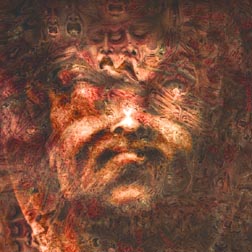
The Catholic Church has revealed how growing interest in Satanism and the occult has led to a rise in exorcisms across Queensland.
One priest, who asked not to be named for fear of "reprisals", said he was carrying out at least one exorcism a fortnight.
More requests for exorcisms came from the Gold Coast than anywhere else.
An exorcism involves holy water, sacrament and Bible reading and can go on for many hours, the priest said. Linda Blair made the subject famous in the 1973 film, The Exorcist.
"Being possessed by a demon is terrifying in one's mental and emotional life," he said. "Some of these manifestations are extremely powerful, causing people to be plagued by disturbances. They hear voices and see hideous creatures in their sleep.
"There has been a recruitment of pagan practices, and it's sheer poison.
"The Gold Coast is not good at all. I do far more exorcisms there than Brisbane."
The Catholic Church has vowed to "fight the devil head-on" by training hundreds of priests as exorcists. Bishop Brian Finnigan, acting head of the Catholic Archdiocese of Brisbane, said it was important for the church to carry out exorcisms.
"People need to be freed of that burden," he said.
Father Gabriele Amorth, 82, the Pope's Exorcist-in-Chief, announced the initiative recently amid church concerns about an increase in people dabbling in the occult. Under plans being considered, each bishop would have a group of priests in his diocese who were specially trained in exorcism.
Father Amorth said: "Too many bishops are not taking this seriously and are not delegating their priests in the fight against the devil. You have to hunt high and low for a proper, trained exorcist."
Queensland Catholic priests can carry out exorcisms only if they have been authorised by an archbishop.
The priest source, who is based in Brisbane, is the only one permitted to do exorcisms in the state. He said he had travelled to Rockhampton, Cairns, Townsville and Toowoomba to save people.
"We are not very plentiful and certainly need more of us to cope with the big occult following that is emerging today," he said.
"It's frightening what can happen when you invite entities into your life which are not meant to be part of God's world."
He said one woman he had met had been plagued by demonic manifestations since taking part in a playground witch game as a child.
Ritual of Dealing With Demons
Undergoes a Revival
In Poczernin, Poland the Rev. Andrzej Trojanowski, a soft-spoken Pole, plans to build a "spiritual oasis" that will serve as Europe's only center dedicated to performing exorcisms. With the blessing of the local Catholic archbishop and theological support from the Vatican, the center will aid a growing number of Poles possessed by evil forces or the devil himself, he said.
"This is my task, this is my purpose -- I want to help these people," said Trojanowski, who has worked as an exorcist for four years. "There is a group of people who cannot get relief through any other practices and who need peace."
Exorcism -- the church rite of expelling evil spirits from tortured souls -- is making a comeback in Catholic regions of Europe. Last July, more than 300 practitioners gathered in the Polish city of Czestochowa for the fourth International Congress of Exorcists.
About 70 priests serve as trained exorcists in Poland, about double the number of five years ago. An estimated 300 exorcists are active in Italy. Foremost among them: the Rev. Gabriele Amorth, 82, who performs exorcisms daily in Rome and is dean of Europe's corps of demon-battling priests.
"People don't pray anymore, they don't go to church, they don't go to confession. The devil has an easy time of it," Amorth said in an interview. "There's a lot more devil worship, people interested in satanic things and seances, and less in Jesus."
Amorth and other priests said the resurgence in exorcisms has been encouraged by the Vatican, which in 1999 formally revised and upheld the rite for the first time in almost 400 years.
Although a Vatican official denied reports in December of a campaign to train more exorcists, supporters said informal efforts began under Pope John Paul II -- himself an occasional demon chaser -- and have accelerated under Pope Benedict XVI. A Catholic university in Rome began offering courses in exorcism in 2005 and has drawn students from around the globe.
One of the recruits is the Rev. Wieslaw Jankowski, a priest with the Institute for Studies on the Family, a counseling center outside Warsaw. He said priests at the institute realized they needed an exorcist on staff after encountering an increase in people plagued by evil.
Typical cases, he said, include people who turn away from the church and embrace New Age therapies, alternative religions or the occult. Internet addicts and yoga devotees are also at risk, he said.
"This is a service which is sorely needed," said Jankowski, who holds a doctorate in spiritual theology. "The number of people who need help is intensifying right now."
Jankowski cited the case of a woman who asked for a divorce days after renewing her wedding vows as part of a marriage counseling program. What was suspicious, he said, was how the wife suddenly developed a passionate hatred for her husband.
"According to what I could perceive, the devil was present and acting in an obvious way," he said. "How else can you explain how a wife, in the space of a couple of weeks, could come to hate her own husband, a man who is a good person?"
Jankowski said that an archbishop granted him the authority last October to perform exorcisms and that he's been busy ever since. As for the afflicted wife? "We're still working with her," he said.
Exorcists said the people they help can be in the grip of evil to varying degrees. Only a small fraction, they said, are completely possessed by demons -- which can cause them to display inhuman strength, speak in exotic tongues, recoil in the presence of sacred objects or overpower others with a stench.
In those cases, the exorcists must confront the devil directly, using the power of the church to order it to abandon its host. More often, however, priests perform what some of them refer to as "soft exorcisms," using prayer to rid people of evil influences that control their lives.
Exorcisms remain a touchy subject even among priests who perform them, aware that the rite is associated with medieval witch-burnings and the 1973 Hollywood horror film, "The Exorcist."
More recent horror stories have also taken their toll. In Germany, memories are still fresh of a 23-year-old Bavarian woman who died of starvation in 1976 after two priests -- thinking she was possessed -- subjected her to more than 60 exorcisms. In 2002, a German bishop resigned after a woman accused him of sexually abusing her during an exorcism.
Exorcists said they are careful not to treat people suffering from mental illness, and that they regularly consult with psychologists and physicians. At the same time, they said, conventional medical therapy often neglects spiritual ailments.
"My remedy is based on spiritual means, which cannot be replaced by any pharmaceutical remedies," said Trojanowski, the priest who is overseeing plans for the new exorcism center. "I do not stop at the level of just treating symptoms. I'm very much interested in the soul of a person. As a priest, I keep asking questions a doctor will never ask."
Trojanowski is a priest in the northwestern Polish port city of Szczecin. He said that he sees as many as 20 people a week who are under the influence of evil spirits, but that he needs more space to treat them properly. At his exorcism center, he said, people could check in for a few days and receive ministrations.
Plans for the center were announced in December after an archbishop gave approval to build it on church land in Poczernin, a village surrounded by cabbage fields about 20 miles outside Szczecin.
The news came as a bit of a shock to the villagers, who said they hadn't been consulted and weren't sure they liked the idea of demons coming home to roost.
"People are worried about the potential for crazy people coming here," said Ksawery Nyks, 50, a longtime resident. He said most people were opposed unless the church could guarantee the exorcism center would have adequate security.
Others were more sympathetic. "I don't think it's going to harm us," said Romnalda Banach, 46, who runs a food shop on the muddy street that runs through the heart of the village. "Every person, if he or she needs help, should be able to get it somehow."
Source: The Courier Mail (AU)
http://www.news.com.au/couriermail/story/0,23739,23223768-3102,00.html


